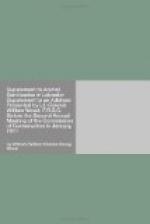I have very little to add to what I said about sanctuaries in the Address. Most of the information received since it was published has only emphasized the points it made. And as no one has opposed and many have supported the establishment of the Harrington sanctuary I again recommend it strongly. The 64 miles in a straight line between cape Whittle and cape Mekattina should be made into an absolute sanctuary for all birds and mammals. If some more ground can be taken in on either side, so much the better. But the 64 miles must be kept in any case. The Bird rocks and Bonaventure island, one of the Mingans, the Perroquets, Egg island and The Pilgrims, are all desirable in every way. There are plenty of islands to choose from along the Atlantic Labrador and round Hudson and James bays. It is most important to keep the migratory birds free from molestation during the first fortnight after their arrival; and the same applies to migratory mammals, though not quite in the same way. Inland sanctuaries should be made near Hamilton inlet, in the Mingan and Mistassini districts and up the Eastmain river. Ultimately an Arctic sanctuary might be made on either Baffin or Melville islands. A meteorological station in the Arctic, linked up with Labrador by wireless, would be of great benefit to the weather forecasts, as we now have no reports from where so much of our cold or mild winters are affected by the different drift of enormous ice-fields; and whenever one is established, a wild-life protection station should accompany it.
Sanctuaries should never be too big; not one tenth of the whole area will ever be required for them. But they should be placed where they will best serve the double purpose of being natural wild “zoos” and over-flowing reservoirs of wild-life. The exact situations of most, especially inland, will require a good deal of co-operative study between zoologists and other experts. But there is no doubt whatever, that they ought to be established, no matter how well the laws are enforced over both leaseholds and open areas. Civilised man is appreciating them more and more every day; and every day he is becoming better able to reach them. By giving absolute security to all desirable species in at least two different localities we can keep objects of Nature study in the best possible way both for ourselves and our posterity.
Only twelve years ago forty mills were debasing the immemorial and gigantic sequoia into mere timber in its last refuge in California. But even the general public sees now that this was a barbarous and idiotic perversion of relative values. What is a little perishable timber, for which substitutes can be found elsewhere, compared with a grove of trees that will be the wonder and delight of generations? What is the fleeting but abominable gratification of destroying the harmless lizard-like Tuatera of New Zealand compared with the deep interest of preserving it as the last living vertebrate that takes us back to Primary times? What is the momentary gratification of wearing egret feathers compared with the certainty of soon destroying the herons that produce them altogether; or what can compensate for the vile cruelty done to mutilated parent birds and starving young, or the murder of Bradley, the bird warden when trying to protect them?




